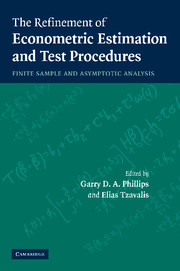Book contents
- Frontmatter
- Contents
- List of figures
- List of tables
- List of contributors
- Preface
- Acknowledgements
- Michael Magdalinos 1949–2002
- Introduction
- 1 Conditional Heteroskedasticity Models with Pearson Disturbances
- 2 The Instrumental Variables Method Revisited: On the Nature and Choice of Optimal Instruments
- 3 Nagar-Type Moment Approximations in Simultaneous Equation Models: Some Further Results
- 4 Local GEL Methods for Conditional Moment Restrictions
- 5 Limit Theory for Moderate Deviations From a Unit Root Under Weak Dependence
- 6 The Structure of Multiparameter Tests
- 7 Cornish-Fisher Size Corrected t and F Statistics for the Linear Regression Model with Heteroscedastic Errors
- 8 Non-Parametric Specification Testing of Non-Nested Econometric Models
- 9 Testing for Autocorrelation in Systems of Equations
- 10 Alternative Approaches to Estimation and Inference in Large Multifactor Panels: Small Sample Results with an Application to Modelling Asset Returns
- 11 Judging Contending Estimators by Simulation: Tournaments in Dynamic Panel Data Models
- 12 A Statistical Proof of the Transformation Theorem
- 13 On the Joint Density of the Sum and Sum of Squares of Non-Negative Random Variables
- 14 Conditional Response Analysis
- References
- Index
14 - Conditional Response Analysis
Published online by Cambridge University Press: 22 September 2009
- Frontmatter
- Contents
- List of figures
- List of tables
- List of contributors
- Preface
- Acknowledgements
- Michael Magdalinos 1949–2002
- Introduction
- 1 Conditional Heteroskedasticity Models with Pearson Disturbances
- 2 The Instrumental Variables Method Revisited: On the Nature and Choice of Optimal Instruments
- 3 Nagar-Type Moment Approximations in Simultaneous Equation Models: Some Further Results
- 4 Local GEL Methods for Conditional Moment Restrictions
- 5 Limit Theory for Moderate Deviations From a Unit Root Under Weak Dependence
- 6 The Structure of Multiparameter Tests
- 7 Cornish-Fisher Size Corrected t and F Statistics for the Linear Regression Model with Heteroscedastic Errors
- 8 Non-Parametric Specification Testing of Non-Nested Econometric Models
- 9 Testing for Autocorrelation in Systems of Equations
- 10 Alternative Approaches to Estimation and Inference in Large Multifactor Panels: Small Sample Results with an Application to Modelling Asset Returns
- 11 Judging Contending Estimators by Simulation: Tournaments in Dynamic Panel Data Models
- 12 A Statistical Proof of the Transformation Theorem
- 13 On the Joint Density of the Sum and Sum of Squares of Non-Negative Random Variables
- 14 Conditional Response Analysis
- References
- Index
Summary
Introduction
We are pleased to have this opportunity to make a contribution to this book in memory of a distinguished Greek econometrician. Michael Magdalinos, from the early years as a PhD student to more recent years when he made important contributions to the literature on hypothesis testing and in particular the role of higher-order approximations to improve inference, impressed the first author by his considerable technical abilities, his tenacity in solving problems, and his warmth as a friend and colleague. Though it was to theoretical econometrics that Michael made his contributions, ultimately the value of many theoretical results lies in applications. We review an issue in applied econometrics in this chapter, namely the efficacy of alternative methods of response analysis in economic policy investigations.
From the 1950s, dynamic simultaneous equations models (DSEM) were a major tool in applied macroeconometric modelling (see for example Klein, Ball, Hazlewood and Vandome, 1961; Klein, 1969), with dynamic multipliers (Goldberger, 1964) being the construct used to measure policy responses. However, following the critiques of economic time-series analysis made by Box and Jenkins (1976) and Granger and Newbold (1974), namely that ignoring non-stationarity in data has serious consequences, time-series models involving differences of data became prevalent. Sims (1980) also criticized DSEMs for employing incredible untested identifying restrictions, and proposed that vector autoregressions (VAR) be used instead. Indeed Sims (1980) was a major influence leading to the VAR becoming the dominant class of model for macroeconometric modelling, and to impulse response analysis being the conventional form of response analysis.
- Type
- Chapter
- Information
- The Refinement of Econometric Estimation and Test ProceduresFinite Sample and Asymptotic Analysis, pp. 347 - 367Publisher: Cambridge University PressPrint publication year: 2007



